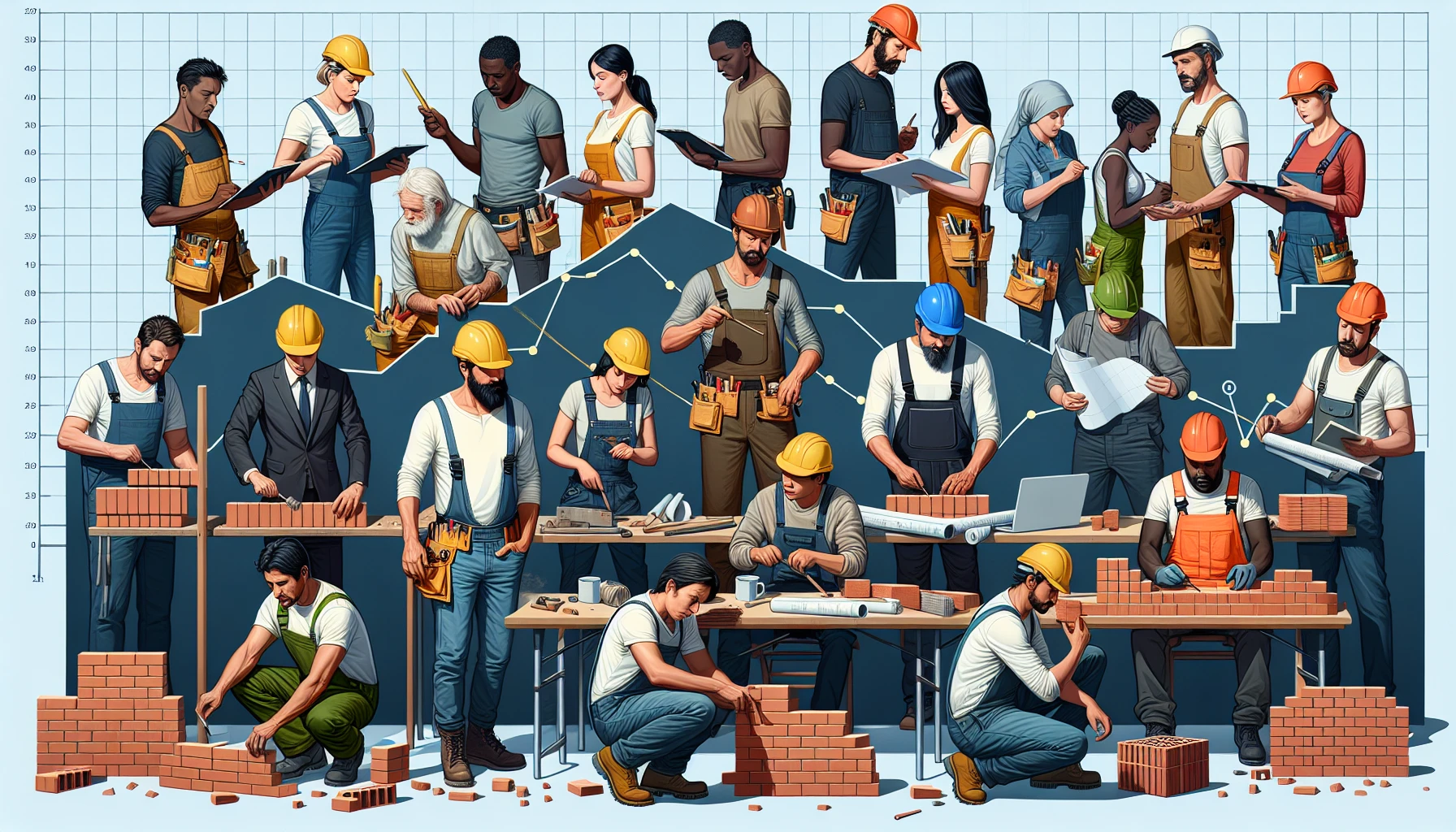Forecasting the Future: Will Construction Costs Go Down in 2024?

Forecasting the Future: Will Construction Costs Go Down in 2024?
The post Forecasting the Future: Will Construction Costs Go Down in 2024? appeared first on UK Construction Blog.
Forecasting the future of construction costs has always been a challenge due to the multitude of factors that can influence prices, such as economic conditions, market demand, and technological advancements. In this blog post, we will explore the numerous aspects that play a role in shaping construction costs and present a detailed analysis of what to expect in 2024, specifically addressing the question: will construction costs go down in 2024?
Key Takeaways
- The economic landscape, interest rates, inflation and market demand all influence construction costs.
- The UK construction forecast for 2024 predicts a 12% recovery due to strong development pipelines and increased building materials costs.
- Mitigating cost increases requires understanding material price factors and planning ahead in order to capitalize on new opportunities sustainably.
The Economic Landscape and Construction Costs

The construction industry is closely tied to the overall economic landscape, with variables such as interest rates, inflation, and market demand playing a significant role in determining construction costs. When the economy is strong, the construction sector tends to thrive, as people invest in new projects and infrastructure. However, when the economy is weak, construction activity may slow down, leading to reduced demand for materials and labour, and potentially impacting costs.
Not all economic aspects uniformly affect the construction industry. For instance, while higher interest rates may make borrowing money more expensive, thus increasing construction financing costs, inflation can lead to increased material and labour costs, further affecting overall project expenses. Market demand, on the other hand, can be a double-edged sword, with high demand driving up costs due to increased competition for resources and personnel, while low demand can lead to reduced economies of scale and increased costs for individual projects.
Interest Rates and Their Impact on Construction Financing
Interest rates have a significant influence on construction financing. An increase in interest rates leads to a rise in borrowing costs, which in turn increases the total cost of a building project. Recently, UK interest rates have been rising, hitting their highest point since the 2008 financial crisis. As a result, the construction industry has had to adapt by carefully considering the implications of interest rate changes on project costs and financing, including scaling back, suspending, or even terminating projects in response to rising interest rates and the subsequent slowdown in the economy.
Inflation’s Role in Material and Labour Costs in 2024
Inflation is another economic factor that can significantly impact construction costs. As inflation rises, so do the prices of raw materials and other construction materials, subsequently placing pressure on contractors’ budgets. Moreover, inflation leads to increased expenses for materials and commodities, affecting labour hiring rates and wages, and resulting in higher labour costs for construction projects.
Inflation can create economic growth volatility, leading to fluctuating construction costs. This necessitates strategic planning from contractors to lessen inflation’s impact on their projects.
Market Demand: A Double-Edged Sword
Market demand, influencing the pricing and demand for construction services, can benefit or burden the construction industry. When there is high demand for construction projects, the prices for construction services tend to rise. Conversely, when there is low demand, prices may decrease. This relationship between supply and demand helps to determine the cost of construction projects in the industry.
Heightened demand can result in sustained construction costs, but it can also stimulate construction activity and provide opportunities for growth in various sectors and regions.
Projected Trends in Construction Materials Prices

The cost of construction materials is heavily influenced by fluctuations in commodity markets, supply chain disruptions, and global demand. In recent years, the construction industry has experienced significant price elevations in raw materials due to factors such as trade disputes and supply chain disruptions. These price fluctuations have a direct impact on overall construction costs, as they affect the cost of raw materials used in construction projects.
Understanding the factors that affect material prices and planning ahead can help contractors mitigate potential increases in building materials costs. Subsequent sections will further analyse projected trends in construction materials prices, particularly steel and lumber, and the impact of supply chain disruptions on the construction industry.
Steel and Lumber: Commodities on the Move
Steel and lumber are two key materials in the construction industry, and their prices have experienced considerable fluctuations in recent years. In 2021, steel prices rose by 77.4%, while timber prices increased by 80% in the first half of the year. Several factors, including:
- Supply shortages
- Demand
- Raw material costs
- Trade policies and tariffs
can sway steel and lumber prices in the construction industry.
Despite recent trends hinting at a decrease in steel and lumber prices, overall construction commodity prices have stayed high with no signs of reduction. Fluctuations in these material prices can significantly impact overall construction costs, necessitating contractors to factor these in when planning their projects.
The Ripple Effect of Supply Chain Disruptions
Supply chain disruptions can be caused by various factors, including:
- Pandemics
- Material scarcity
- Delays in construction
- Interruptions of energy or services
- Deficiencies in logistics and warehousing
These disruptions can create ripple effects across the construction industry, leading to increased material prices and project delays.
Consequently, contractors may struggle to stay within budget due to material shortages, shipment delays, and increased costs. Understanding and addressing supply chain disruption causes can help contractors more effectively navigate these challenges and handle their projects’ disruption impacts.
Labour Market Dynamics and Construction Expenses

The labour market significantly influences construction expenses since the availability and cost of skilled workers directly affect overall project costs. A recent study revealed that 25% of construction businesses in the UK were experiencing skilled labour shortages. Labour shortages can result in wage increases, further impacting construction costs.
In addition to labour shortages, variations in immigration regulations and population trends can also impact the labour market and, consequently, construction costs. Subsequent sections will analyse the importance of skilled workers in upholding construction quality and the relationship between wage increases and efficiency gains in the construction industry.
Skilled Workers: The Backbone of Construction Quality
Skilled construction workers, with their proficiency, expertise, and familiarity with construction materials, are essential to maintaining construction quality and producing superior work efficiently. The availability of skilled workers can significantly impact construction project costs, since a shortage of skilled workers can lead to elevated labour costs because of competition for scarce talent.
With the current high demand for skilled personnel in the UK construction sector, it is estimated that an additional 45,000 workers per annum will be required by 2027 to meet the growing construction demand.
Wage Increases Versus Efficiency Gains
With increasing wages, the construction industry needs to counterbalance these higher labour costs with efficiency gains to manage construction expenses. By implementing strategies such as:
- Enhancing workplace conditions
- Optimizing communication methods
- Allowing for flexible schedules
- Reducing tech distractions
Businesses can maintain productivity levels even as wages rise.
Efficiency gains, including the utilization of Building Information Modelling (BIM) and prefabrication, can also help offset the effect of wage increases by augmenting worker productivity and generating more output in the same amount of time, counterbalancing the greater labour costs associated with wage increases and contributing to build cost reduction.
Innovation’s Role in Shaping Building Costs

Innovation also plays a significant role in shaping construction costs. As the construction industry continues to evolve, the implementation of novel approaches and technologies can yield varying results in terms of cost. In some cases, these new methods can expedite the process and reduce the overall cost of construction projects. However, they may also necessitate additional training and specialized equipment, which could lead to an increase in cost.
Subsequent sections will analyse how innovations like Building Information Modelling (BIM) and prefabrication can decrease building costs and enhance project efficiency, with the help of a building cost information service.
Building Information Modelling (BIM) and Cost Management
Building Information Modelling (BIM) is a digital tool for creating a virtual model of a building before its physical construction. BIM facilitates improved cost management in construction projects by providing:
- Enhanced accuracy in cost estimating
- Reduction of unbudgeted changes
- Improved cost estimation accuracy
- Long-term cost savings
Contractors can utilize BIM technology to better visualize and plan their projects, leading to improved project efficiency, reduced waste, and positively impacting construction costs.
Prefabrication and Modular Construction: Cost-Saving Frontiers
Prefabrication and modular construction are innovative techniques that offer cost-saving opportunities by streamlining processes and reducing waste. Prefabrication refers to the practice of manufacturing components of a building in a factory prior to assembling them on the construction site, while modular construction involves constructing pieces like large puzzles and connecting them together.
By utilizing these techniques, contractors can achieve significant time and cost savings, as well as increased efficiency and overall build cost reduction, leading to reduced construction waste.
Government Policies and Infrastructure Projects

Government policies and infrastructure projects also play a role in shaping construction costs. Planning permission, building codes, and public investment can all influence the cost of construction projects by imposing regulations, requirements, and financial support.
Subsequent sections will assess the impact of planning permission and building codes on construction costs, along with the effect of government investment in affordable housing and public works projects.
Planning Permission and Building Codes
Planning permission and building codes encompass regulations and requirements that can influence construction costs. In the UK, obtaining planning permission involves:
- Submitting a planning application to the local authority
- The local authority reviews the proposal
- The local authority makes a decision in accordance with planning regulations and guidelines.
Building codes, on the other hand, stipulate the minimum standards and requirements for the design, construction, and upkeep of buildings. Adherence to these regulations often necessitates additional materials, labour, and design considerations, thus raising construction costs. Furthermore, updates to building codes, such as those intended to reduce carbon emissions or enhance energy efficiency, may necessitate the use of costlier technologies or materials, further impacting construction costs.
Investment in Affordable Housing and Public Works
Government investment in affordable housing and public works projects can stimulate construction activity and impact costs. Some examples of government spending on public works include:
- Building new roads and bridges
- Constructing public transportation systems
- Developing affordable housing projects
- Renovating and improving existing infrastructure
Government spending on public works is comparable to that of other countries, with the UK’s per-person expenditure being similar to Australia’s, but lower than some European countries.
Public works projects can have a substantial effect on construction costs. Variables such as will construction costs in 2024 be influenced by:
- Project insurance
- Inflation
- Taxation
- Financing
can directly influence the costs related to the development of public works projects.
Southern Construction Framework and Regional Developments
The Southern Construction Framework (SCF) and regional developments play a role in localized cost control and regional economic growth. The SCF is a construction procurement framework that seeks to deliver public sector construction and development in the region, encompassing education, health, and local infrastructure.
Subsequent sections will assess the role of SCF operations in localized cost control and how regional economic growth affects construction costs.
SCF Operations Lead and Localized Cost Control
The SCF operations lead contributes to better cost control and efficiency in regional construction projects by:
- Implementing stringent cost control measures
- Ascertaining optimum specifications and avoiding over-specification
- Assisting in predicting costs accurately
- Managing price volatility in materials supply
- Facilitating better control over project costs
By employing strategies such as:
- meticulous planning and budgeting
- precisely defining permissible and impermissible labour rates
- comprehensive project planning
- embracing proactive strategies to avert cost overruns
The SCF operations lead helps to manage construction costs in the southern UK regions.
The Influence of Regional Economic Growth
Regional economic growth can influence construction costs by affecting local demand and supply dynamics. As the construction industry expands in a region with robust economic growth, there is often increased demand for construction materials and labour. This can result in higher costs for inputs such as materials and labour, as well as potential deficiencies in the supply of skilled workers.
Moreover, regional economic growth can also influence the availability and cost of construction materials, as increased demand may exert pressure on the supply chain.
The Forecast for UK Construction in 2024
As we look ahead to 2024, the UK construction forecast predicts a 12% recovery, with structural changes creating new opportunities in various sectors of the industry. This recovery is expected to be driven by:
- Strong development pipelines
- Improved credit conditions
- Pent-up demand for commercial projects
- Major infrastructure projects
- Increased building materials costs
Subsequent sections will analyse what this anticipated recovery implies for costs and the new opportunities that could result from structural changes in the industry.
Anticipating a 12% Recovery: What It Means for Costs in 2024
A 12% recovery in the UK construction industry is expected to impact costs through:
- Increased demand and market dynamics
- Rise in the cost of construction materials
- Increase in labour costs due to increased demand for construction services
- Supply chain issues
- Inflation
These factors can contribute to higher costs in the construction industry.
Although a significant decrease in UK construction costs is unlikely in 2024, understanding material price factors and planning ahead can help contractors alleviate potential increases in building materials costs.
Structural Changes and New Opportunities
Structural changes in the construction industry could result in new opportunities in logistics, office and retail refurbishment, and commercial premises repurposing. The implementation of novel approaches and technologies can not only expedite the process and reduce the overall cost of construction projects, but also accommodate changing needs, leverage technological advancements, and utilize new processes.
By embracing these structural changes and capitalizing on the new opportunities they present, the construction industry can continue to grow and evolve, meeting the challenges of tomorrow while maintaining cost efficiency and sustainability.
Summary
In conclusion, the future of construction costs is influenced by a multitude of factors, including economic conditions, market demand, technological advancements, and government policies. As we look forward to 2024, a 12% recovery in the UK construction industry is anticipated, with structural changes offering new opportunities for growth and development. By understanding the factors that affect construction costs, planning ahead, and embracing innovation, contractors can better navigate the challenges and uncertainties of the future, ensuring the successful completion of their projects while maintaining cost efficiency and sustainability.
Frequently Asked Questions
Will building materials go down 2024?
It appears that the cost of construction materials will remain high in 2024, with an average jump of 19% already seen in 2020.
Are building material costs coming down?
Despite a 39% price increase in August 2020, building material costs have experienced a 1.8% fall over the last 12 months and a 0.7% decline in the last month (Sep 2023). Despite this, sales of materials across the sector have declined due to a decrease in availability.
What factors contribute to the volatility of construction costs?
Construction costs are highly volatile due to economic conditions, market demand, technological advancements, and government policies all influencing them.
How do interest rates and inflation impact construction costs?
Higher interest rates and inflation can significantly increase costs for construction projects, making them more expensive to undertake. As a result, construction costs can be affected by fluctuations in both interest rates and inflation.
Comments are closed